Well bottom filter: arrangement technology and overview of filtration materials
If you plan to use well water as drinking water, it will require serious preparation. To get rid of particles of soil and organics that fall into the mine during the set in the bucket, you need to arrange a filter for the well. Inexpensive, structurally simple system will clean, and in some cases even disinfect water. Safety in these conditions is crucial, do you agree?
You will find all about the types of well filters and methods of their construction in our article. We scrupulously examined all effective types of filtering well circuits, options for their arrangement and described the materials approved for use in this matter.
With our help, you will receive detailed answers to questions arising from owners of plots with a well. You will find useful tips for caring for bottom filters. Photo and video applications will help to perceive information faster and easier.
The content of the article:
Functionality of the bottom filter
The bottom filter is a layered embankment of various natural materials that are not washed away by well water. Water passing through the filter is cleaned of debris, harmful impurities and suspended particles present in the well.
The device of the bottom filter is mandatory in the following cases when:
- protection of the bottom of the well from erosion is required;
- water flow is carried out under high pressure;
- fine or dusty sand at the bottom of the well;
- a quicksand opens a well;
- protection of clogging-sensitive pumping equipment is needed;
- the water level in the well is characterized by large differences, for example, during pump operation or precipitation;
- unsatisfactory water quality: turbidity, sediment, unpleasant odor. Read more about the causes of unsatisfactory water quality and how to eliminate them can be found in this stuff.
The installation of a bottom filter is not necessary in the case when the well has opened hard fractured clay or rock formation. Do not use bottom protection if water comes from natural springs. If the dense bottom of the well is not clogged with impurities and suspended particles, additional filtration is not necessary.
In other cases, in order to obtain high quality water, installing a bottom filter for a well is a must.
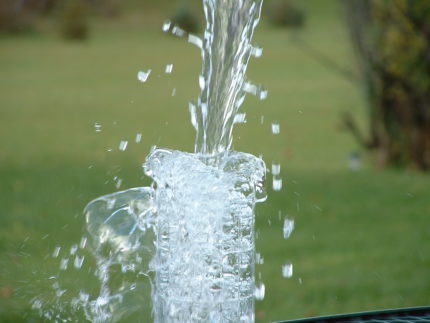
Well bottom materials
The bottom filter consists of filtering bulk materials, through which water is purified physically and chemically. Physical cleansing means purification from debris and suspensions, and chemical cleansing means purification from impurities and harmful compounds.
Today in the store you can buy ready-made bottom filters for wells based on silver, activated carbon and river pebbles. Unfortunately, the cost of such filters is quite high, so most owners of wells prefer to make bottom filters with their own hands.
Materials used for the arrangement of bottom filters must meet the following requirements:
- sufficient density and weight so as not to float in the well;
- non-rotting, mold resistant;
- neutrality, lack of chemical reactions;
- high level of filtration;
- environmental Safety.
The following materials are used as materials for filters installed at the bottom of wells:
A tribute to tradition - quartz sand
This material is easy to find on the banks of rivers and natural lakes. The grains of sand have a diameter of up to 1 mm, the color is yellowish, translucent. Before laying in the well, silica sand must be washed several times.
You can do this as follows:
- Pour a layer of sand 5-10 cm into the container and pour water.
- Mix thoroughly and leave for 30 seconds.
- Carefully drain the water in which particles of debris and silt will remain, and the sand will settle to the bottom of the tank.
- Repeat 2-3 times until the drained water is clear.
Washing will help eliminate clay particles and organic impurities.
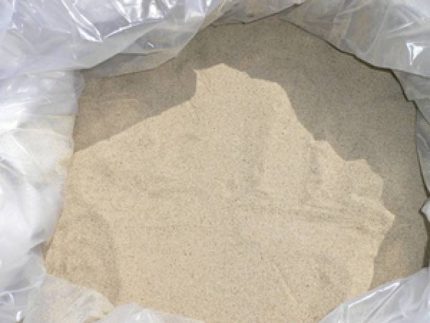
Large and medium river pebbles
Common bulk material also found on river banks. Pebbles of different sizes, rounded in shape without sharp edges.
Before using as a bottom filter, pebbles should be washed with clean water. Some advise to heat the pebbles with heat, placing them in the oven for several minutes.
Natural Gravel
Loose rock of natural origin, particle sizes of gravel - 2-20 mm.
Before laying in the well, this material must undergo a thorough multi-stage washing, as due to the impressive amount of voids between the components, gravel is able to accumulate clay and silty particles. Slag gravel should not be used due to the probably high amount of harmful impurities.
Jadeite - aerobatics
Jadeite or bath stone is a mineral semi-precious stone of natural origin, which includes silver and silicon.
This mineral has many positive properties that allow you to effectively use it for the device of the bottom filter:
- purifies water of heavy metals;
- disinfects
- prevents the movement of bottom materials (sand, sandy loam);
- does not absorb water, which means it will last a long time.
The disadvantages of this material include the need to purchase it (jadeite is mined in quarries, not the fact that deposits are located in your region). The cost of the mineral is from 60 rubles / kg.
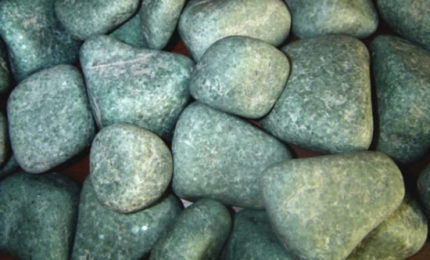
Shungite - a water purifier
Material representing large particles of petrified oil.
Shungite has the ability to effectively clean well water from:
- petroleum products;
- heavy metals;
- organic impurities;
- microorganisms;
- excess iron (iron taste of water);
- suspensions, turbidity.
Shungite also has the useful property of saturating well water with trace elements valuable to living organisms.
This material is quite expensive in cost, but its use is indispensable for wells located near industrial enterprises and highways.
Zeolite - an elite material
Zeolite is a natural porous material of volcanic origin. It is a natural sorbent that absorbs nitrates and compounds of heavy metals.
It helps to reduce the radioactive background, destroys phenols and other substances harmful to humans, plants and animals. The effectiveness of this material as a bottom filter is expensive - from 600 rubles per 10 kg.
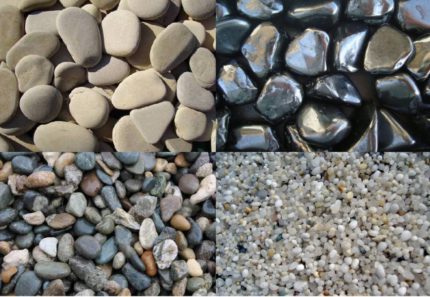
Geotextile - a barrier against pollution
Sometimes a polymeric material is used for the device of the bottom filter - high-density geotextile. The peculiarity of this filter is that it perfectly filters physical suspensions without improving the chemical and bacteriological parameters of water.
The use of dense geotextiles as the main material for the filter is advisable if a small amount of gas, such as hydrogen sulfide, enters the well.
Prohibited Materials
Many well owners make a serious mistake using the following materials for the bottom filter device:
- Secondary construction gravel. The material obtained by crushing dismantled reinforced concrete structures will absorb water without filtering it.
- Expanded clay. It has a low density and eventually pops up in a well. It releases harmful substances.
- Granite crushed stone. In most cases, this material has an increased background radiation.
- Building limestone crushed stone. It contains a large amount of lime, the excess of which will reduce the quality of well water.
Washed gravel, sand and natural gravel are suitable for bottom filters.
Soil filter device at the bottom of the well
It is impossible to create an effective bottom filter using only one of the materials described above; the best option is a multilayer filter device using several types of materials of different sizes.
There are two types of filter installation: direct and reverse. The choice of one type or another depends on the soil lining the bottom of the well and the pressure force of the incoming water. In 9 out of 10 cases, a more effective inverse filter is used.
Direct filling option
A three-layer direct filter is the type in which the material of the largest fraction is located at the bottom, then the middle layer is located - the size of the fraction is 5-7 times smaller than the first layer, and at the top the third layer is quartz sand or small river pebbles. The thickness of each layer should be 15-20 cm, which means that the entire filter will take 50-60 cm of the depth of the well.
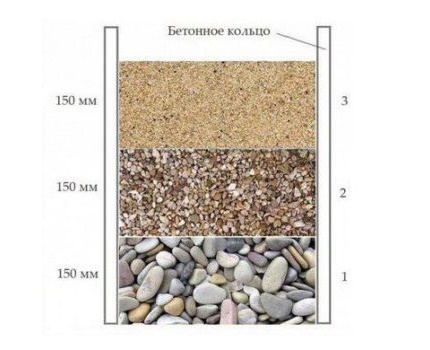
Procedure for installing a direct bottom filter:
- well bottom preparation: garbage disposal, silt and other pollution;
- bottom filling a layer of 15-20 cm of a large fraction: jadeite, zeolite, large river or sea pebbles;
- backfill materialand the middle fraction: river or sea pebbles, medium gravel, fine zeolite, shungite;
- upper layer formation fine fraction: quartz sand, small pebbles.
A direct filter is used on floating soils (together with a shield), as well as on sandy and loose soils with a small pressure of incoming water. In this case, the main function of the direct filter is to conduct a phased purification of water.
Reverse Layout
A return filter is a type of well filter in which laying is carried out in layers from fine-grained material to larger filtering elements. The main function of the inverse filter is to prevent fine debris and sand from penetrating into the upper layers. The return filter protects the bottom of the well from erosion. It is used on sandy and sandy loamy soils with calm water flow.
Procedure for installing the reverse bottom filter:
- Preparation of a well and bulk materials.
- The filling of the lower fine-grained layer: quartz sand, fine pebbles.
- The filling of the middle fraction layer: river pebbles, gravel, zeolite, shungite.
- Coarse layer filling: large stones more than 5 cm, jadeite, pebbles, geotextiles.
As with the direct filter device, the thickness of each layer should be 15-20 cm. All bulk materials should be washed with running water before laying in the well to remove clay particles and organic contaminants.

Varieties of Well Shields
Bottom shield - a wooden shield made of boards in the shape of a circle, used in the case when the influx of water into the well occurs with high pressure, as well as in the presence of quicksand. The main function of the bottom shield is to protect the bottom and filter from erosion. For installation in a well, two types of shields are used: wooden and metal (mesh).
Shield made of wood for laying on the bottom
In comparison with metal, wooden boards have the following advantages:
- Environmental Safety.
- The wood used has bactericidal properties.
- Not subject to corrosion.
- Lower cost and ease of manufacture.
A wooden bottom shield can be made independently using one of the materials:
- oak - long-lasting strong breed, which can give a specific bitter taste to water;
- larch - durable material that does not affect the quality and taste of well water. The service life is much shorter than that of oak;
- aspen - wood of high strength, has disinfecting properties, does not rot, has a long service life.
To make the shield, you need to take several wooden boards and tightly fasten them with stainless steel nails. It is better to connect with wooden dowels, under which in advance boards holes are drilled in adjacent boards. The diameter of the shield should be slightly less than the diameter of the well, for this a circle is drawn, and the extra boards are cut with a jigsaw.
5-10 mm holes are made on the entire surface of the shield, through which water will flow.
To ensure better water circulation, the shield should have wooden “legs”, their role is played by two bars 5-7 cm thick, on which boards are inflated from above.
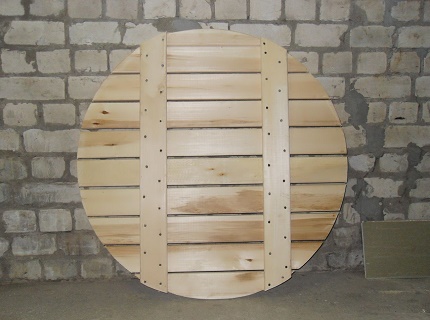
Elements of a reverse bottom filter are laid on the shield: first, coarse-grained materials that do not allow the shield to rise under the influence of water flows. In the presence of strong quicksand the shield will gradually be sucked into the ground, so it will need to be installed every 3-7 years.
Metal bottom fixture
The bottom shield for the well can be made with your own hands from a metal mesh with a fine mesh structure.
The advantages of such a shield:
- high strength and durability;
- does not affect the taste of water over time;
- Reliably filters sand and debris of various sizes and origin.
A stainless steel mesh with a mesh size of not more than 2 by 2 mm is used to make a metal shield. The grid is placed between two identical circles of metal. Circles are cut out of sheet metal and correspond to the diameter of the well. The shield is installed on the backfill layer of large stones with a thickness of 10 cm, fastening is carried out using pins mounted in the wall of the well.
The elements of the bottom filter are poured onto the mesh.It is worth noting that the service life of the mesh is from 5 to 10 years, over time, the metal begins to deform and rust, losing its filtering properties, which means that the mesh shield needs to be replaced.
Wall filter in the well
In the case when the flow of water entering the well is very weak, and filtration is also carried out through its walls, then the device of the bottom filter is not advisable. In such a situation, the best option would be to install a wall filter.
To make a wall filter, it is necessary to cut V-shaped openings located horizontally in the very lower part of the well (lower reinforced concrete ring), where filter elements from coarse concrete are installed.
Concrete for filters is prepared using medium fraction gravel and cement of the M100-M200 grade without adding sand. Cement is diluted with water until the mixture becomes creamy, after which pre-washed gravel is poured into it and thoroughly mixed. The resulting solution is filled into the cut holes and left until completely solidified.
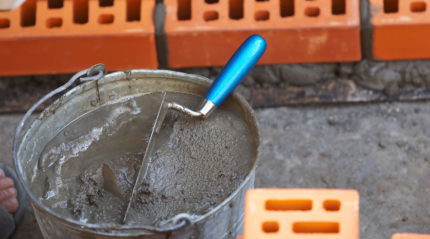
Bottom Filter Care
Having equipped the bottom filter in the well, do not forget to clean it at least once a year. In addition, do not forget to regularly carry out preventive water disinfection in the well
The technology for cleaning the bottom filter consists of the following steps:
- Removing the filter elements and bottom shield from the well.
- Cleaning the bottom shield or replacing it.
- Flushing or replacing recovered rocks.
- Stacking materials in the same order.
Timely cleaning of the bottom filter will help maintain conditions for clean water intake from the well all year round.
Conclusions and useful video on the topic
Do-it-yourself device of the bottom filter using materials of various fractions:
The device of the bottom filter using a wooden shield and shungite:
Production of an aspen shield for a bottom filter on quicksand:
The installation of filters for water from a well is not a complicated process that can be performed independently without the involvement of specialists and unnecessary financial investments.
The cost of a well filter depends entirely on what materials you have chosen as filtrates. With proper installation and timely cleaning of the bottom filter, you will always have access to clean and tasty water.
Have questions about arranging a bottom filter for a well? Or is there experience in arranging well filters and can you share useful information? Please ask your questions, leave comments and suggestions in the block below.

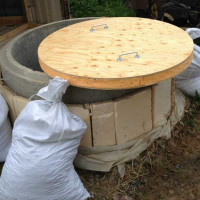 Do-it-yourself well warming for the winter: an overview of the best materials and methods of warming
Do-it-yourself well warming for the winter: an overview of the best materials and methods of warming 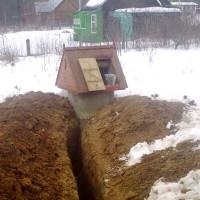 Winter water supply from a well: an overview of the best options and arrangement schemes
Winter water supply from a well: an overview of the best options and arrangement schemes 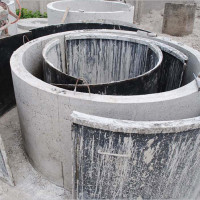 DIY rings for a well: step-by-step technology for manufacturing reinforced concrete rings
DIY rings for a well: step-by-step technology for manufacturing reinforced concrete rings 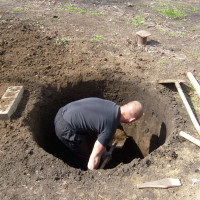 Digging a well with your own hands: types of well structures + an overview of the best digging technologies
Digging a well with your own hands: types of well structures + an overview of the best digging technologies 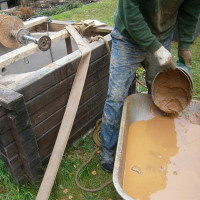 Do-it-yourself well cleaning: a review of the best preventative and capital methods
Do-it-yourself well cleaning: a review of the best preventative and capital methods 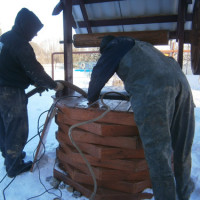 Water purification from a well: an overview of the best and most effective ways
Water purification from a well: an overview of the best and most effective ways  How much does it cost to connect gas to a private house: the price of organizing gas supply
How much does it cost to connect gas to a private house: the price of organizing gas supply  The best washing machines with dryer: model rating and customer tips
The best washing machines with dryer: model rating and customer tips  What is the color temperature of light and the nuances of choosing the temperature of the lamps to suit your needs
What is the color temperature of light and the nuances of choosing the temperature of the lamps to suit your needs  Replacement of a geyser in an apartment: replacement paperwork + basic norms and requirements
Replacement of a geyser in an apartment: replacement paperwork + basic norms and requirements
The well is very important, because in my country house, for example, it is the main source of drinking water, and if we approach responsibly the creation of a bottom filter, the water quality will be an order of magnitude higher than that of a tap in an apartment! I myself made a similar direct filter from the materials described, plus added some nuances from myself, for reliability. The water is filtered amazingly, the color is transparent, without impurities, no odors!
Can a second-hand bath stone be used again? He does not lose his properties? We want to buy new stones in a new bathhouse, and use the old ones as a filter in the well. The composition of the water ceased to suit us, the well was not properly equipped. We’ll also try to take 50 cm of land along the perimeter of the well and fill it with red clay, it is full of it in our countryside, we will make a water seal. After we want to pour sand around the well in the form of a hill so that the embankment is above the level of the earth around. Hope this helps make water quality better.
The general problem with the quality of drinking water or its lack makes us think about building our own well. After all, before in many yards we had wells. But it seems that everyone is in the same village, and the quality of water is different for everyone. We don’t have a well, but we go to our neighbors for well water. It is very old, the walls are lined with stone. They say that the water in the well should be constantly updated, then it will be fresh and clean.
Here I puzzle what to do with a well. There was normal non-potable water - watered, washed, washed, washed dishes. I decided to clean it. Seven rings - smeared current seams, cleaned. Now the water comes from the bottom rusty 16 mg per liter.
They advised to fill the bottom ring with sand and put something else on top. Someone says that white limestone crumb helps, someone shouts “granite!”, But I’m thinking about shushgit. I also decided to open the seams back.